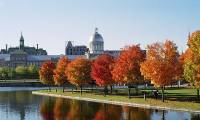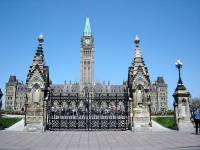Canada
Canada is an independent federative state. It is one of the most developed countries.
Canada consists of ten provinces and two territories.
It is situated on the North American continent. In size Canada is the second in the world after Russia. Its area is almost 10 million km2.
The capital of Canada is Ottawa, which is situated on the bank of the Ottawa River. It is famous for its beautiful parks. It is also known as the city of bridges.
Canada is very rich in forest, minerals and fur-bearing animals. It holds the first place in the world in the amount of forests. It is rich in the following natural resources: non-ferrous metals, uranium, oil, natural gas, coal.
Canadian industries produce cars, airliners, locomotives, sea vessels, snow-removal machines, and agricultural equipment. The most developed industries are timber, mining, chemical, meat and milk and food industries. Canada grows wheat, barley, flax, potatoes, vegetables and fruit. Fishing is also one of the prosperous industries.
Official languages of Canada are English and French. Nearly 60 percent of the population speak English and 27 percent speak French. The rest speaks other languages, such as Eskimo, Indian, German, Ukrainian and Italian.
Canada is a founding member of the United Nations. It has been active in a number of major UN agencies.
National Symbols of Canada
Canada has many symbols that are used to represent it here at home and around the world. This page shows some of those symbols and gives a little information about each. For provincial symbols visit this site's provinces page.
Canadian Colours - Red and white are the official colours of Canada. They were designated Canada's official colours by King George V on 21 November, 1921, in the proclamation of the Royal Arms of Canada.
The Maple Leaf and Tree -The maple leaf is Canada's most prominent symbol, recognized as Canadian all around the world. According to many historians, the maple leaf began to serve as a Canadian symbol as early as 1700. The maple tree was officially proclaimed the national arboreal emblem of Canada on 25 April, 1996.
The Flag - The maple leaf flag of Canada was first raised on 15 February, 1965. The flag, designed by George Stanley, was picked from a number of proposals. The first ever maple leaf flag was stitched by Joan O'Malley. For more information about Canada's flag visit this site's flags page.
Canadian Colours - Red and white are the official colours of Canada. They were designated Canada's official colours by King George V on 21 November, 1921, in the proclamation of the Royal Arms of Canada.
The Coat of Arms -The Canadian coat of arms were given to Canada by His Majesty King George V on 21 November, 1921. The arms reflect the royal symbols of Britain and France. On the shield there are the three royal lions of England, The royal lion of Scotland, the royal harp of Ireland, and the royal fleurs-de-lis of France. On the bottom of the shield there is a sprig of three maple leaves representative of Canadians of all origins. The ribbon around the shield has the motto of the Order of Canada: "Desiderantes Meliorem Patriam". (They desire a better country). The arms of Canada show a royal helmet, which is a barred helmet of gold looking outward and draped in a mantle of white and red. On the royal helmet is the crest. This symbol consists of a wreath of twisted white and red silk on which stands a crowned gold lion holding in its right paw a red maple leaf. The lion is a symbol of valour and courage. The crest is used to mark the sovereignty of Canada. The supporters on either side of the arms are a lion and a unicorn holding the British and French flags. Under the supporters is Canada's Motto: "A Mari usque ad Mare" (From sea to sea). At the bottom of the arms are the English rose, the Scottish thistle, the Irish shamrock, and the French fleurs-de-Lis. At the top of the arms is the imperial crown.
The Maple Leaf and Tree -The maple leaf is Canada's most prominent symbol, recognized as Canadian all around the world. According to many historians, the maple leaf began to serve as a Canadian symbol as early as 1700. The maple tree was officially proclaimed the national arboreal emblem of Canada on 25 April, 1996.
The Beaver -Another symbol of Canada is the beaver. The beaver has played an important role in the history of Canada since the first explorers arrived here and started the fur trade. It has been used in emblems by many Canadian companies throughout the years. From the Hudson's Bay Company to the Canadian Pacific Railway. The beaver was made an official emblem of Canada on 24 March, 1975 when royal assent was given to "an act to provide for the recognition of the beaver (castor canadensis) as a symbol of the sovereignty of Canada".
Источники
http://www.canada4life.ca/symbols.php
http://engmaster.ru/topic/2427


